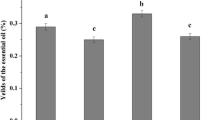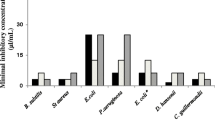Currently there is increasing interest in the potential uses of plant essential oils as natural biological agents and botanicals. Variations in the yield, chemical composition and biological activities of hydrodistilled essential oils from sweet basil (Ocimum basilicum L.) harvested from various agro-climatic regions of Saudi Arabia were appraised. The content of sweet basil essential oils (SBEOs) varied between 1.19 and 1.80% across the regions. GC-MS/GC-FID analysis of the essential oils confirmed the presence of a total of 47 compounds representing 97.4 to 99.2% of total oil composition with linalool (25.33 – 36.09%) and estragole (60.88%) as the principal components followed by methyl eugenol (2.40 – 26.43%) and α-bergamot (1.14 – 6.51%). SBEOs were dominated by oxygenated monoterpenes (48.73 – 71.52%) along with notable amounts of phenylpropanoids (3.13 – 27.70%) and sesquiterpene hydrocarbons (9.55 – 17.83%). The oils, compared with standard drugs and the major components, showed notable antibacterial action against B.subtilis, E.coli and S. aureus strains and were also quite effective against pathogenic molds such as A. flavus, A. niger and F. solani. Based on the present results, a significant variation in the oil yield, volatiles composition and antibacterial attributes of SBEOs were noticed as function of different agro-climatic regions. Provisional upon morphological and biochemical diversity of basil populations, the tested SBEOs exhibited notable variation (p < 0.05) in the yield, chemical composition as well as biological principles studied. The verified basil chemotypes can be explored as the native source for production of linalool and estragole rich essential oils with promising antioxidant and antimicrobial value and thus can be explored for pharmaceutical uses.
Similar content being viewed by others
References
S. A. Bazaid, M. S. El-Armoudi, E. F. Ali, and E. S. Abdel-Hameed, J. Med. Plant. Res., 1(5), 119 – 128 (2013).
A. I. Hussain, F. Anwar, S. T. H. Sheraziand, and R. Przybylski, Food. Chem., 108(3), 986 – 995 (2008).
O. K. H. Khattab, A. A. El-Nasr, M. Haggag, and W. Samir, Egypt. J. Hosp. Med., 23(26), 656 – 676, (2015).
K. Poonkodi, J. Crit. Rev., 3(3), 56 – 64, (2016).
A. P. Raina, A. Kumar, and M. Dutt, Hortic. Sci., 60(5), 1727 – 1735, (2008).
H. Kruger, S. B. Wetze, and B. Zeiger, J. Herbs Spices Med. Plants., 9(4), 335 – 344, (2002).
H. Sher and A. Aldosari, Sci. Res. Essays., 7(16), 1639 – 1646, (2012).
M. A. Rahman, M. M. S. Al-Said, and M. A. Al-Yahya, Fitoterapia, 75(2), 149 – 161, (2004).
A. H. A. Ba-Hamdan, M. M. Aly, and S. O. Bafeel, Afr. J. Microbiol. Res., 4(1), 1 – 9, (2014).
R. P. Adams, Identification of Essential Oil Components by Gas Chromatography / Mass Spectrometry, Allured. Pub. Corp., Carol Stream, IL (2001).
R. A. Baily, Design of Comparative Experiments, Cambridge University Press (2008).
S. Dehganpour and F. P. Taheril, J. Med. Plants. Res., 7(9), 30 – 39, (2016).
S. J. Luiz, C. Filho, A. F. Blank, et al., Rev. Bras. Farmacogn., 16(1), 24 – 34, (2006).
G. Opalchenova, and D. Obreshkova, J. Microbiol. Meth., 54(1), 105 – 110, (2003).
A. Avetisyan, A. Markosian, M. Petrosyan, et al., BMC Complem. Altern., 60(1), 60, (2017).
S. R. Vani, S. F. Cheng, and C. H. Chuah, Am. J. Appl. Sci., 6(3), 525 – 528, (2009).
N. Saikia, and S. C. Nath, Int. Book. Dist. Dehr. Dun, Jorhat. India, 24, 71 – 74, (2003).
P. Pripdeevech, W. Chumpolsri, P. Suttiarporn, and S. Wongpornchai, J. Serb. Chem. Soc., 75(11), 1503 – 1513, (2010).
M. M. Ozcan, O. Erel, and E. E. Herken, J. Med. Food., 12, 198 (2009).
M. Jamzad, F. Mokhber, S. Ziareh, and M. Yari, J. Med. Plants Res., 7, 1618 – 1623 (2013).
S. N. Ebrahimi, J. Hadian, M. H. Mirjalili, et al., Food. Chem., 110, 927 – 931, (2008).
O. Y. Celiktas, E. E. H. Kocabas, E. Bedir, et al., Food. Chem., 100(2), 553 – 559, (2013).
R. Sharafati-Chaleshtori, N. Rokni, M. Rafieian-Kopaei, et al., J. Agric. Sci. Tech., 17(4), 817 – 826, (2015).
M. Ozcan, and J. C. Chalchat, Czech. J. Food. Sci., 20(6), 223 – 228, (2000).
O. Politeo, M. Jukicand, and M. Milos, Food. Chem., 101(2), 227 – 230, (2009).
Acknowledgements
The authors are grateful to Deanship of Scientific Research at Prince Sattam Bin Abdulaziz University Al-Kharj, Saudi Arabia for provision of financial aid to conduct this research work under Project # 2015/03/4722.
CONFLICT OF INTEREST
The authors declare that they have no conflict of interest.
Author information
Authors and Affiliations
Corresponding author
Rights and permissions
About this article
Cite this article
Anwar, F., Alkharfy, K.M., Mehmood, T. et al. Variation in Chemical Composition and Effective Antibacterial Potential of Ocimum basilicum L. Essential Oil Harvested from Different Regions of Saudi Arabia. Pharm Chem J 55, 187–193 (2021). https://doi.org/10.1007/s11094-021-02384-2
Received:
Published:
Issue Date:
DOI: https://doi.org/10.1007/s11094-021-02384-2




